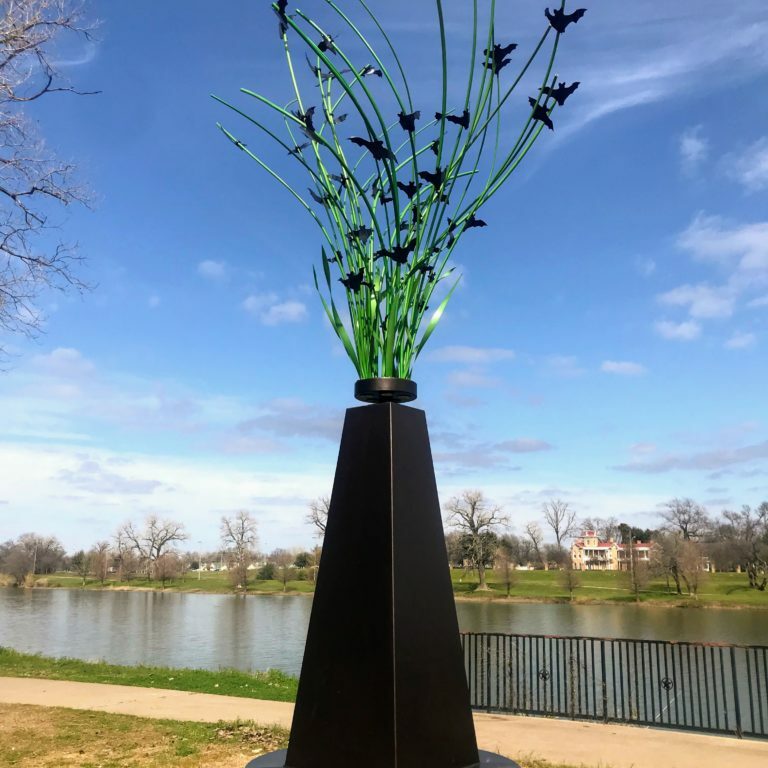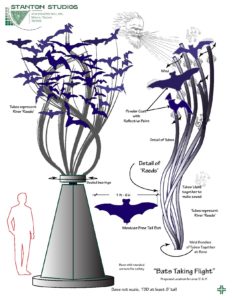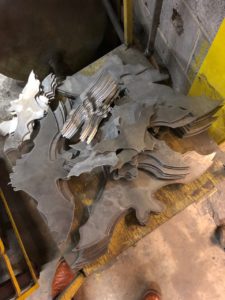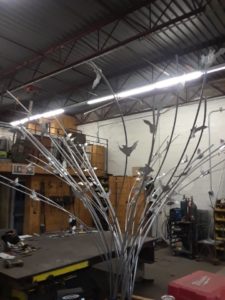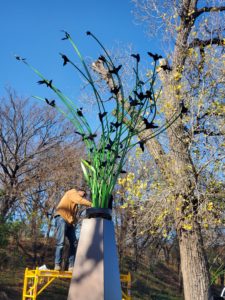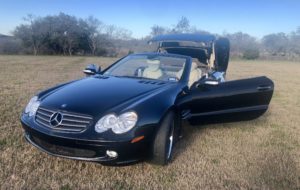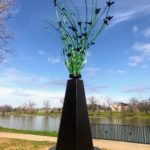Bats Taking Flight
As an artist, Bryant J. Stanton likes to observe nature and draw inspiration from what he sees. He is particularly drawn to patterns in nature, divine proportions, and the Fibonacci sequence. The coordinated, frantic, serpentine flight patterns of Mexican Free-Tail bats interested Stanton, as they fly out in an orchestrated swirl into the night sky.
His piece, Bats Taking Flight, plays on the wind moving the silhouetted bats about on long sinuous tubes of aluminum striking neighboring tubes, and generating ‘tinny-clanking’ sounds.
The silhouetted bats are painted with a reflective, deep-blue color, representing bats at dusk. The reflective paint picks up on ambient light, headlights of passing cars, and beams from flashlights, all bouncing off of the painted bats and reeds. The bouncing, reflected light, contrasted against the dark park surroundings, appear as illuminated bats flying about.
In creating this piece, Stanton enlisted the help of John Nickell and George Johns with Nickell Metalsmiths in Waco.
Click here for a detailed description by the artist.
By Bryant J. Stanton
Waco artist Bryant J. Stanton got his start in stained glass in the late 1970s making suncatchers. After a year, he started his own company at the age of 21 called Stanton Glass Studio. Bryant’s first commercial job came from restoring stained glass windows from a church that was damaged by a fire.
Stanton’s studio has grown to become nationally recognized with works in homes, churches and businesses across Texas and the United States. Stanton has much more experience than just glass, and specializes in working with wood and metal, too. You can see several examples of his work in famous buildings. Here in Waco, you may have noticed the “Green Door” on the 8th block of Austin Avenue, and the DNA double helix sculpture in the science building at McLennan Community College.
View all sculptures by this artist.Donated By
 Cindy & Mike Gustin
Cindy & Mike Gustin
Sponsors of “Bats Taking Flight” aka “Batmobile”
My husband Mike was out of town and on one balmy evening, I decided to put the top down on my black Mercedes SL500 convertible and take a drive. While going down Valley Mills, my phone rang, so I pulled into the Wendy’s parking lot so I could put the top up and return the call. Now putting the top up on this car makes for quite a spectacle. The trunk flips opens, the roof folds up, deposits itself inside, everything closes up automatically and the windows roll up. While all this was going on, a man with a bunch of kids came out of Wendy’s, all with ice cream. The kids were following him like little ducks, and when he stopped, they all stopped in unison behind him. He looked over at my car with the top folding up and truck lid going up and down and said, “Look at that car. It’s the Batmobile!!!”
Ever since, I’ve referred to my little convertible as the Batmobile, and in fact, I later got license plate frames that say this. When we first saw the drawing and description of the sculpture, it was originally called “The Batmobile” which immediately caught our attention. I believe since that time, it’s been renamed “Bats in Flight” but it will always be “The Batmobile” to us. Not only were we drawn to it because of the name, the kinetic movement incorporated in its construction was fascinating. We are very happy to make this donation to the Sculpture Zoo!
We also wanted to honor our granddaughters, Hannah and Campbell Gustin, so they will always have an important, beautiful and unique piece of art named in their honor.
Betsy and Clifton Robinson, Cindy and Mike GustinDid You Know?
- There are over 1,400 species of bats worldwide and bats can be found on nearly every part of the planet expect extreme deserts and polar regions.
- Not all bats hibernate! Some bat species survive by migrating in search of food to warmer areas when it gets chilly.
- Bats have very few natural predators and their biggest threat is actually disease
- Without bats, bananas, avocados, and mangos would most likely cease to exist as they depend on bats for pollination. Bats also spread seeds for nuts, figs, and cacao.
- Bats are the only living true flying mammal and are very fast at it! Some bats can reach speeds of over 100 miles per hour.
- There are wild bat colonies up and down the banks of the Brazos River. If you want to see live bats up close, there is a very cool bat cave enclosure at Cameron Park Zoo.
Location

